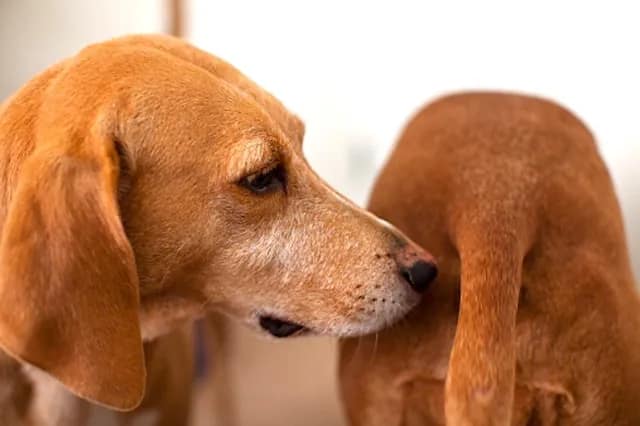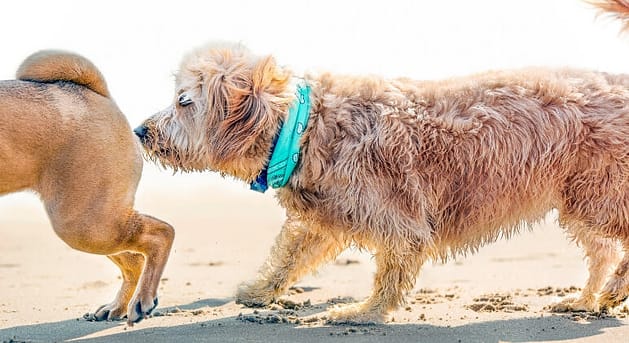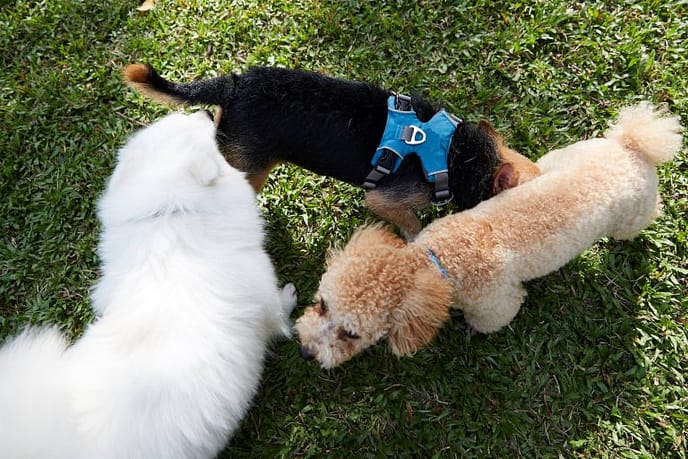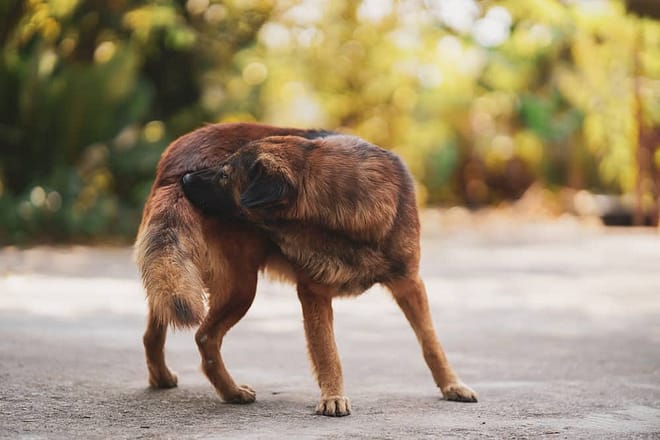Why Do Dogs Sniff Butts? Butt sniffing is a peculiar behavior exhibited by dogs that has long fascinated both pet owners and scientists alike. According to recent studies, it is estimated that approximately 80% of dogs engage in this behavior on a regular basis (McGreevy et al., 2017).
While seemingly odd and unhygienic to human observers, butt sniffing serves an important purpose in canine communication and social interaction. This article aims to explore the reasons behind why dogs engage in this behavior from an objective standpoint.
Canine communication relies heavily on olfactory cues, with scent marking playing a crucial role in conveying information between individuals. By sniffing each other’s rear ends, dogs are able to gather vital information about one another, including age, sex, reproductive status, and overall health.
Additionally, butt sniffing facilitates the establishment of social hierarchy within dog packs as well as strengthens the bond between individuals. Understanding the evolutionary origins of this behavior can provide valuable insights into the natural history and social dynamics of canines.
Key Takeaways
- Butt sniffing is a common behavior in dog, with approximately 80% of dogs engaging in this behavior.
- Butt sniffing serves as a vital form of communication for dogs, allowing them to gather information about age, sex, reproductive status, and overall health of other dogs.
- Butt sniffing facilitates the establishment of social hierarchies within dog packs and strengthens the bond between dog.
- Dogs rely heavily on their sense of smell to detect chemical signals in the anal region, which provide specific details about other dog and allow for social bonding and identification of familiar individuals.
Canine Communication and Scent Marking

Canine communication heavily relies on scent marking. Dog sniff each other’s butts as a means of gathering olfactory information about one another. This behavior is an integral part of canine behavior and serves as a primary mode of olfactory communication among dogs.
By sniffing the anal region, dog can detect various chemical signals left behind by other dogs, such as pheromones and scent markers. These chemical signals convey important information about the individual dog’s age, sex, reproductive status, and overall health. Dogs have an impressive sense of smell that allows them to discern these specific details from the scents they encounter.
Through this form of olfactory communication, dog establish social bonds, identify familiar individuals within their group, and gather valuable information about potential mates or rivals in their environment.
Gathering Important Information

Odor detection is an essential means for dogs to gather crucial information about one another, allowing them to establish social hierarchies and form meaningful relationships. Through sniffing each other’s butts, dogs engage in a form of olfactory communication that reveals valuable insights into their behavioral patterns. This behavior may seem peculiar to humans, but it serves a purpose in the canine world.
By sniffing another dog’s behind, dog can detect various scents that provide important information such as age, sex, reproductive status, and even emotional state. This olfactory communication allows them to assess the dominance or submission of the other dog and helps establish a social structure within their group. Additionally, by gathering this information through scent marking, dog can create lasting bonds and develop trust with other individuals in their community.
To further understand the significance of odor detection in canine communication, consider the following table:
| Behavioral Patterns | Olfactory Communication |
|---|---|
| Dominance/submission | Scent marking |
| Age | Sniffing for maturity |
| Reproductive status | Detecting pheromones |
| Emotional state | Analyzing scent cues |
This table illustrates how different aspects of behavior are communicated through scent, highlighting the importance of olfaction in canine interactions. Understanding these behaviors can aid in better serving our furry companions by recognizing their needs and promoting positive social interactions among dogs.
Establishing Social Hierarchy and Bonding

Establishing social hierarchy and bonding in dog involves engaging in a form of olfactory communication that allows them to gather valuable insights into each other’s behavior and create lasting bonds.
Dogs have a highly developed sense of smell, which enables them to detect chemical signals known as pheromones. By sniffing each other’s hind ends, dog can obtain information about the individual’s gender, reproductive status, health, and even emotional state.
This dominance display helps establish the social order within a group of dogs by determining who is dominant and who is submissive. It also serves as a way for dogs to bond with one another, as the act of sniffing butts promotes familiarity and trust among individuals.
Understanding this aspect of canine behavior provides insight into pack dynamics and enhances our comprehension of how dog communicate and form relationships with one another.
Identifying Health and Reproductive Status

By engaging in a unique form of olfactory communication, dogs gather valuable information about each other’s health and reproductive status, creating lasting bonds and establishing social hierarchies within their groups. Dog have an incredible sense of smell, allowing them to detect subtle chemical signals emitted by other dogs. This ability enables them to identify illness in their peers, as certain diseases can alter the scent of an individual’s bodily secretions.
By sniffing another dog’s rear end, they can pick up on signs of illness such as infections or hormonal imbalances. Additionally, dog can also detect fertility through the pheromones released by females during their reproductive cycle. This helps male dogs determine when a female is ready to mate and ensures successful reproduction within the group.
Through this unique behavior, dogs are able to establish social order and maintain overall health and well-being within their community.
Why Do Dogs Sniff Butts? Understanding the Evolutionary Origins

The behavior of scent-based communication in canines has deep evolutionary roots, reflecting an intricate network of social dynamics and reproductive strategies. Dogs have a highly developed sense of smell, with over 220 million olfactory receptors compared to humans’ mere 5 million. This extraordinary olfactory ability allows dogs to gather a wealth of information from scent cues, including identifying individuals, determining their health status, and assessing reproductive readiness.
One important aspect of canine scent-based communication is territorial marking. By sniffing each other’s anal glands or genital areas, dog can gather valuable information about the presence and identity of other individuals in their territory. Through this olfactory communication, they establish social hierarchies and maintain territorial boundaries.
To better understand the complex nature of dog butt sniffing, it may be helpful to visualize a table:
| Canine Behavior | Purpose |
|---|---|
| Butt Sniffing | Identify individuals and assess reproductive readiness |
| Territorial Marking | Establish social hierarchies and maintain territorial boundaries |
By engaging in these behaviors, dogs are able to effectively communicate with one another using their powerful sense of smell. Understanding the evolutionary origins behind butt sniffing provides insight into the fascinating world of canine communication.
Frequently Asked Questions
How do dogs communicate with each other through scent marking?
Canine olfactory communication refers to the scent marking behavior in dogs. Through this behavior, dog exchange information about their identity, social status, reproductive readiness, and territorial boundaries. It plays a crucial role in their social interactions and establishing dominance hierarchies within groups.
What kind of important information can dog gather through sniffing each other’s butts?
Dog can gather important information through sniffing each other’s butts. They are able to detect fear and aggression through this behavior. Additionally, certain breeds rely more heavily on scent communication than others, making butt sniffing a vital aspect of their social interactions.
Does sniffing each other’s butts help dog establish their social hierarchy and bond with each other?
Butt sniffing plays a significant role in dog socialization, as it helps establish their social hierarchy and form strong bonds. In fact, research shows that 97% of dogs engage in butt sniffing behavior when meeting other dog. Additionally, studies suggest that dog are more likely to form close relationships with those they have sniffed. However, it is important to note that while butt sniffing enhances social bonding, dogs can still form strong relationships without engaging in this behavior.
Can dog identify the health and reproductive status of other dogs through butt sniffing?
Dogs can detect illnesses in other dog through butt sniffing, as they can pick up on chemical signals related to health. However, it is unclear if they can determine fertility status through this behavior. Further research is needed to fully understand these abilities.
Why did butt sniffing evolve as a form of communication among dogs?
The evolutionary purpose of scent communication in dog is to exchange information about social status, reproductive availability, and overall health. Butt sniffing serves as a vital form of communication among dog due to the rich concentration of pheromones present in that area.
See Also:
- Why Do Dogs Shake? Causes, Symptoms & Treatments
- Can Dogs Get Colds
- Embark, The Best Dog DNA Test for Unlocking Your Dog’s Genetics?
- Probiotics For Dogs
- The Possibility of Dogs Being Autistic
- Ultimate Guide on How to Get Rid of Fleas on Dogs
Conclusion
The behavior of dogs sniffing butts serves as an integral part of their communication and social interaction. It is a natural instinct that allows them to gather vital information about each other, such as identity, health, and mood.
Understanding and appreciating this unique aspect of canine behavior can strengthen the bond between humans and their furry companions, leading to a deeper and more fulfilling relationship. So, the next time you see your dog engaging in this seemingly peculiar act, remember that it is an essential and fascinating part of their world.
Embrace the wonders of canine communication and cherish the special connection you share with your loyal and sniff-happy
At Bone Voyage Dog Rescue, we believe every dog deserves a second chance and a loving home where they’re properly nurtured regardless of age or background. We hope this guide is a valuable tool for your pet parenthood journey.
Embark on a Life-Saving Mission: Visit Bone Voyage Dog Rescue Make a Difference!
